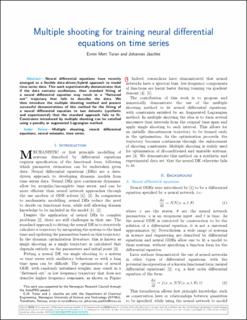| dc.contributor.author | Turan, Evren Mert | |
| dc.contributor.author | Jäschke, Johannes | |
| dc.date.accessioned | 2022-03-04T11:53:27Z | |
| dc.date.available | 2022-03-04T11:53:27Z | |
| dc.date.created | 2021-12-17T11:46:09Z | |
| dc.date.issued | 2021 | |
| dc.identifier.issn | 2475-1456 | |
| dc.identifier.uri | https://hdl.handle.net/11250/2983129 | |
| dc.description.abstract | Neural differential equations have recently emerged as a flexible data-driven/hybrid approach to model time-series data. This work experimentally demonstrates that if the data contains oscillations, then standard fitting of a neural differential equation may result in a “flattened out” trajectory that fails to describe the data. We then introduce the multiple shooting method and present successful demonstrations of this method for the fitting of a neural differential equation to two datasets (synthetic and experimental) that the standard approach fails to fit. Constraints introduced by multiple shooting can be satisfied using a penalty or augmented Lagrangian method. | en_US |
| dc.language.iso | eng | en_US |
| dc.publisher | Institute of Electrical and Electronics Engineers (IEEE) | en_US |
| dc.title | Multiple shooting for training neural differential equations on time series | en_US |
| dc.type | Peer reviewed | en_US |
| dc.type | Journal article | en_US |
| dc.description.version | acceptedVersion | en_US |
| dc.rights.holder | © IEEE. Personal use of this material is permitted. Permission from IEEE must be obtained for all other uses, in any current or future media, including reprinting/republishing this material for advertising or promotional purposes, creating new collective works, for resale or redistribution to servers or lists, or reuse of any copyrighted component of this work in other works. | en_US |
| dc.source.journal | IEEE Control Systems Letters | en_US |
| dc.identifier.doi | 10.1109/LCSYS.2021.3135835 | |
| dc.identifier.cristin | 1969868 | |
| dc.relation.project | Norges forskningsråd: 309628 | en_US |
| cristin.ispublished | true | |
| cristin.fulltext | postprint | |
| cristin.qualitycode | 1 | |
